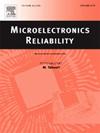添加镍对η'-Cu6Sn5 金属间化合物力学性能的第一性原理研究
IF 1.6
4区 工程技术
Q3 ENGINEERING, ELECTRICAL & ELECTRONIC
引用次数: 0
摘要
无定形镍磷层已被用作阻挡层,用于调节工业环境中金属间化合物(IMC)的形成和生长。在 η'-Cu6Sn5 晶体结构中掺入 Ni 原子后,形成了 η'-(Cu,Ni)6Sn5 的 IMC。检查 IMC 的机械性能对于评估焊点寿命至关重要。基于第一原理计算和 VRH 方法,分析了 η'-Cu6Sn5、η'-Cu5.75Ni0.25Sn5、η'-Cu5.5Ni0.5Sn5 和 η'-Cu5.25Ni0.75Sn5 IMC 的体积模量、剪切模量、弹性模量和硬度值,结果表明 η'- (Cu,Ni)6Sn5 具有更强的各向异性和硬度。所有基于 η'-Cu6Sn5 的 IMC 的 KIC 分别为 1.830、1.933、1.961 和 1.960,这表明在 η'-Cu6Sn5 单元中掺入镍原子会对其机械性能产生有利影响,降低使用过程中界面微裂纹的可能性,并提高接头的抗剪性能。所有基于 η'-Cu6Sn5 的 IMC 的热力学无序参数(TDOS)主要受 Sn-s 和 Cu-d 态的影响,这两种态具有金属特性。研究表明,η'- (Cu,Ni)6Sn5化合物比η'-Cu6Sn5化合物更稳定。这一现象可归因于掺入镍原子后,镍原子与其相邻的铜原子和锡原子之间形成了牢固的共价键。本研究的发现可为今后在焊接中应用 NiP 阻挡层提供有价值的参考点和理论基础。本文章由计算机程序翻译,如有差异,请以英文原文为准。
First-principles study of Ni additions on mechanical properties of η'-Cu6Sn5-based intermetallic compound
Amorphous Ni![]() P layers have been employed as barrier layers to regulate the formation and growth of intermetallic compounds (IMCs) within industrial contexts. The doping of Ni atoms into the crystal structure of η'-Cu6Sn5 resulted in the formation of the IMC of η'- (Cu,Ni)6Sn5. An examination of the mechanical properties of IMCs is crucial for the evaluation of solder joint longevity. Based on first-principles calculations and VRH methods, the bulk modulus, shear modulus and the elastic modulus and hardness values of η'-Cu6Sn5, η'-Cu5.75Ni0.25Sn5, η'-Cu5.5Ni0.5Sn5 and η'-Cu5.25Ni0.75Sn5 IMCs were analyzed, which showed that η'- (Cu,Ni)6Sn5 possessed a stronger anisotropy and hardness. The KIC of all η'-Cu6Sn5-based IMCs are 1.830, 1.933, 1.961, and 1.960, respectively, indicating that the doping of Ni atoms into the η'-Cu6Sn5 cells can favourably affect their mechanical properties reducing the likelihood of microcracking at the interface during use and increasing the shear resistance of the joint. The thermodynamic disorder parameter (TDOS) for all η'-Cu6Sn5-based IMCs is primarily influenced by the Sn-s and Cu-d states, which exhibit metallic properties. It has been demonstrated that the compound η'- (Cu,Ni)6Sn5 is more stable than the compound η'-Cu6Sn5. This phenomenon can be attributed to the formation of robust covalent bonds between the Ni atoms and their neighbouring Cu and Sn atoms, which occurs when Ni atoms are doped. The findings of this research can serve as a valuable reference point and theoretical foundation for future applications of Ni
P layers have been employed as barrier layers to regulate the formation and growth of intermetallic compounds (IMCs) within industrial contexts. The doping of Ni atoms into the crystal structure of η'-Cu6Sn5 resulted in the formation of the IMC of η'- (Cu,Ni)6Sn5. An examination of the mechanical properties of IMCs is crucial for the evaluation of solder joint longevity. Based on first-principles calculations and VRH methods, the bulk modulus, shear modulus and the elastic modulus and hardness values of η'-Cu6Sn5, η'-Cu5.75Ni0.25Sn5, η'-Cu5.5Ni0.5Sn5 and η'-Cu5.25Ni0.75Sn5 IMCs were analyzed, which showed that η'- (Cu,Ni)6Sn5 possessed a stronger anisotropy and hardness. The KIC of all η'-Cu6Sn5-based IMCs are 1.830, 1.933, 1.961, and 1.960, respectively, indicating that the doping of Ni atoms into the η'-Cu6Sn5 cells can favourably affect their mechanical properties reducing the likelihood of microcracking at the interface during use and increasing the shear resistance of the joint. The thermodynamic disorder parameter (TDOS) for all η'-Cu6Sn5-based IMCs is primarily influenced by the Sn-s and Cu-d states, which exhibit metallic properties. It has been demonstrated that the compound η'- (Cu,Ni)6Sn5 is more stable than the compound η'-Cu6Sn5. This phenomenon can be attributed to the formation of robust covalent bonds between the Ni atoms and their neighbouring Cu and Sn atoms, which occurs when Ni atoms are doped. The findings of this research can serve as a valuable reference point and theoretical foundation for future applications of Ni![]() P barrier layers in soldering.
P barrier layers in soldering.
求助全文
通过发布文献求助,成功后即可免费获取论文全文。
去求助
来源期刊

Microelectronics Reliability
工程技术-工程:电子与电气
CiteScore
3.30
自引率
12.50%
发文量
342
审稿时长
68 days
期刊介绍:
Microelectronics Reliability, is dedicated to disseminating the latest research results and related information on the reliability of microelectronic devices, circuits and systems, from materials, process and manufacturing, to design, testing and operation. The coverage of the journal includes the following topics: measurement, understanding and analysis; evaluation and prediction; modelling and simulation; methodologies and mitigation. Papers which combine reliability with other important areas of microelectronics engineering, such as design, fabrication, integration, testing, and field operation will also be welcome, and practical papers reporting case studies in the field and specific application domains are particularly encouraged.
Most accepted papers will be published as Research Papers, describing significant advances and completed work. Papers reviewing important developing topics of general interest may be accepted for publication as Review Papers. Urgent communications of a more preliminary nature and short reports on completed practical work of current interest may be considered for publication as Research Notes. All contributions are subject to peer review by leading experts in the field.
 求助内容:
求助内容: 应助结果提醒方式:
应助结果提醒方式:


